How to Build a Perfect Jira Roadmap with a Roadmap Planner
April 30, 2023 · 11 min read
This article delves into the Jira roadmap view, examining its benefits and outlining the most effective strategies for constructing a project roadmap using a Jira roadmap planner.
What is a Roadmap?
A roadmap is a high-level plan view outlining steps, goals, and milestones within a timeframe, used in project management, product development, or business strategy to communicate plans to stakeholders. A roadmap consists of:
- Overall vision or purpose
- Timeline with dates or deadlines
- Key milestones
- Dependencies
- Resource and responsibilities
- Potential obstacles and risks
Product vs. Project Roadmap
 When exploring a roadmap we should remember that it differs depending on whether you’re working on a project or product. Let’s make a comparison:
When exploring a roadmap we should remember that it differs depending on whether you’re working on a project or product. Let’s make a comparison:
Product Roadmap:
- No final destination; continuous development
- Sets a clear timeline and budget
- Focus on strategic direction
Project Roadmap:
- High-level action plan
- Aligns team and stakeholders with goals
- Highlights essentials for managing expectations and coordinating resources
How to Create Roadmap in Jira
Creating a comprehensive and effective Jira roadmap involves several steps to ensure it aligns with your project goals, facilitates clear communication among stakeholders, and helps in tracking progress. Below is a detailed guide on how to add roadmap to Jira project:
1. Understand Project Requirements
- Identify Goals and Objectives. Define the primary goals and objectives of your project. What are you aiming to achieve?
- Stakeholder Analysis. Identify key stakeholders and understand their expectations and requirements.
- Scope Definition. Clearly outline the scope of the project, including what is in-scope and out-of-scope.
2. Set Up Your Jira Environment
- Create a Jira Project. Start by creating a new project in Jira. Choose the project type that best suits your needs (e.g., Scrum, Kanban, or Business project).
- Configure Project Settings. Set up the project details such as project key, name, and project lead. Configure permissions and notifications according to your team's needs.
3. Define Epics and Initiatives
- Create Epics. Break down your project into major themes or epics. These are large bodies of work that can be divided into smaller tasks.
- Initiatives. If your project is large, group related epics under initiatives for better organization.
4. Use the Roadmap Planner
- Access the Roadmap Planner. Navigate to the Jira software roadmap view in your Jira project.
- Add Epics to the Roadmap. Start by adding the epics you created to the roadmap. Each epic should represent a significant milestone or phase in your project.
- Set Timelines. Assign start and end dates to each epic. This helps in visualizing the project timeline and identifying potential overlaps or dependencies.
5. Breakdown Epics into Stories and Tasks
- Create Stories and Tasks. Break down each epic into smaller, manageable stories and tasks. Ensure each task is actionable and clear.
- Assign to Team Members. Allocate tasks to team members based on their skills and availability.
6. Prioritize Work
- Backlog Grooming. Regularly groom your backlog to ensure the most important tasks are prioritized. Use Jira’s ranking feature to reorder tasks based on priority.
- Sprint Planning. For Scrum projects, plan your sprints by pulling the top-priority items from the backlog into the sprint backlog.
7. Manage Dependencies and Risks
- Identify Dependencies. Use Jira’s linking feature to identify and manage dependencies between tasks and epics.
- Risk Management. Identify potential risks and create contingency Jira plans. Use Jira issues to track and mitigate risks.
8. Monitor Progress
- Track Progress. Use the roadmap to monitor the progress of epics and tasks. Update statuses regularly to reflect current progress.
- Burndown Charts. Utilize Jira’s burndown charts to visualize progress over time and ensure the team is on track.
9. Communicate with Stakeholders
- Share Roadmap. Use Jira’s sharing feature to share the roadmap with stakeholders. Ensure they have the necessary permissions to view or comment.
- Regular Updates. Schedule regular updates with stakeholders to review progress and make necessary adjustments.
10. Review and Iterate
- Retrospectives. Conduct regular retrospectives to review what went well and what could be improved. Use these insights to iterate and improve your roadmap planning process.
- Adjust Roadmap. Based on feedback and project developments, make necessary adjustments to your roadmap. Ensure it remains aligned with project goals and stakeholder expectations.
How to Enable Jira Roadmap Feature
There are several Jira roadmapping options for you to choose: basic Jira roadmap tool called Timeline, Plans (Advanced Jira Planning), and a wide range of Jira add-ons.
1. Timeline (Basic Jira Roadmaps)
Jira's built-in Timeline feature, available by default, is a powerful tool for project management and team collaboration. This feature provides a visual representation of project progress, helping teams to track and manage tasks efficiently.
The Timeline displays issues and tasks along a chronological line, allowing users to see the start and end dates, dependencies, and the overall sequence of work items.
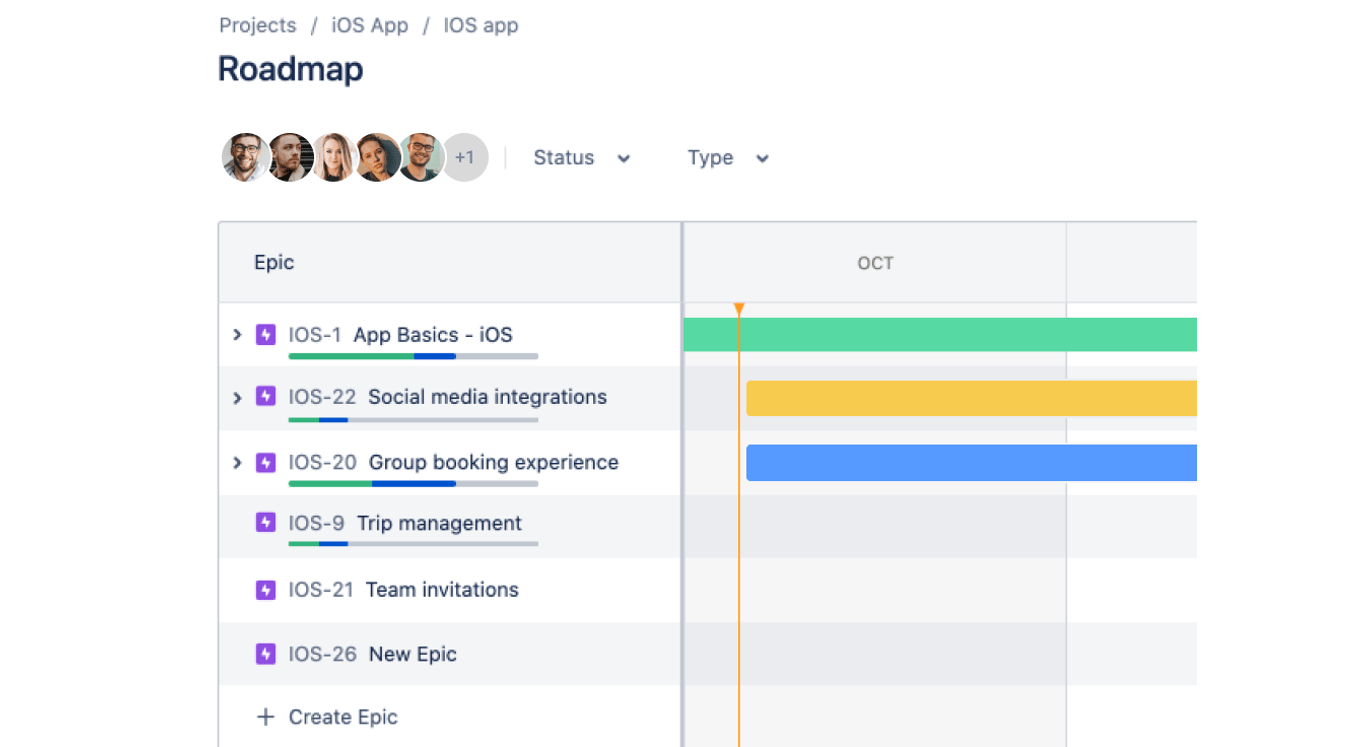
Jira Timeline View Key Features
Epics. Jira epic roadmap shows up as colored bars on the timeline. They represent large bodies of work that can be broken down into smaller issues that become a child issue of the epic.
Child issues. Child issues belong to the epics and represent such issue types as stories, tasks, and bugs.
Dependencies. The Timeline allows users to view and manage dependencies between issues, ensuring that all necessary prerequisites are completed in order.
2. Plans (Advanced Planning)
Advanced planning in Jira leverages a suite of features designed to enhance the strategic management of complex projects. This advanced functionality extends beyond basic task tracking to offer sophisticated tools for project planning, resource allocation, and long-term scheduling. Plans is available as part of Jira Premium and Jira Enterprise.
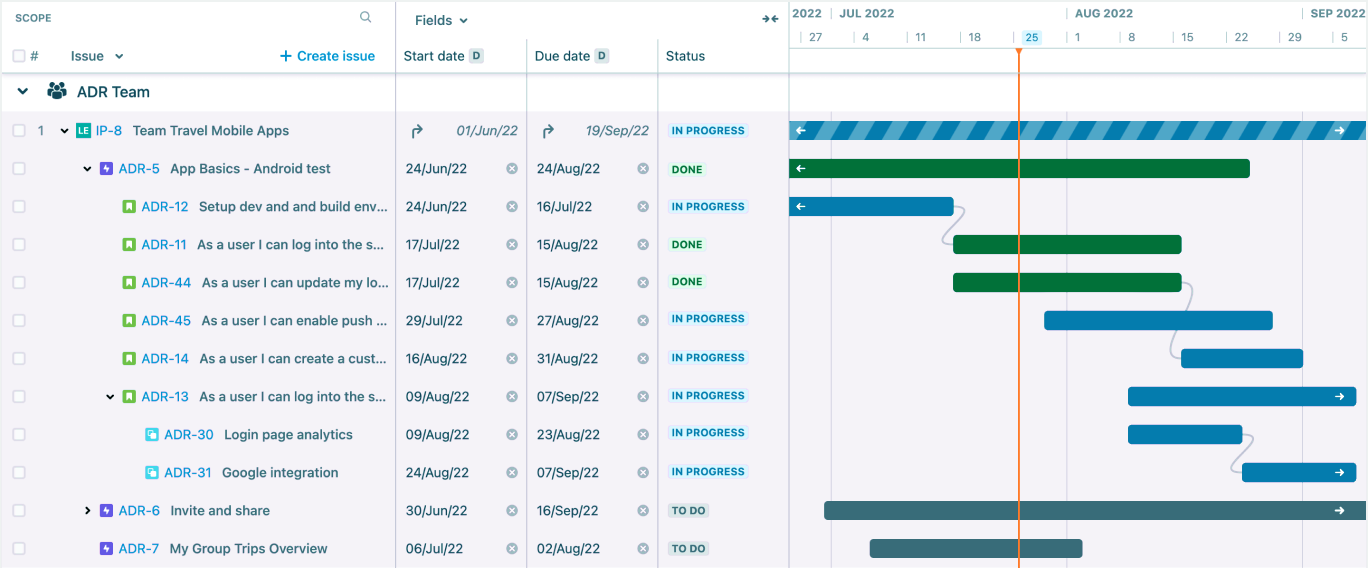
What’s the Difference between Timeline and Plans in Jira?
Let’s discover key features of Advanced Planning in Jira (Plans) compared to basic Jira Timeline:
1. Multi-Project Roadmaps. Plans support comprehensive roadmaps that span multiple projects, providing a unified view of all initiatives across the organization while basic Timeline is limited to visualizing tasks and dependencies within a single project.
2. Scenario Planning. Plans enable users to create and compare multiple what-if scenarios to evaluate different project strategies and their potential impacts while Timeline focuses on the current state of tasks and timelines.
3. Capacity Planning. Plans allow for detailed capacity management, helping to balance workloads and optimize resource allocation across multiple teams and projects.
4. Dependency Management. Plans provide sophisticated tools for managing complex dependencies between tasks and projects, ensuring that all prerequisites are met while Timeline offers basic dependency visualization and management within a single projects.
5. Hierarchy Visualization. Plans' hierarchy can be customized and expanded to track larger goals above the epic level. You can create an initiative hierarchy level to represent a program that includes multiple projects or combined efforts across multiple teams.
6. Advanced Filtering and Views. Plans have enhanced filtering and customizable views, allowing users to focus on specific aspects of their projects, such as team performance or specific timeframes.
7. Customizable Reporting. Plans support advanced reporting capabilities, enabling detailed analysis and insights into project performance, resource utilization, and progress.
8. Team and Role-Based Planning. Plans facilitate planning at the team and role level, allowing for more granular control over who does what and when.
9. Long-Term Forecasting. Plans is capable of long-term forecasting, helping teams plan and predict project outcomes well into the future.
Building a Roadmap in Jira Roadmap Plugin
For a faster and cost-effective way to create a roadmap in Jira, consider using Jira addons. There are many affordable options available in the Atlassian marketplace, such as Planyway. These planners are versatile and can be used for project management, product development, and business strategy.
Planyway for Jira
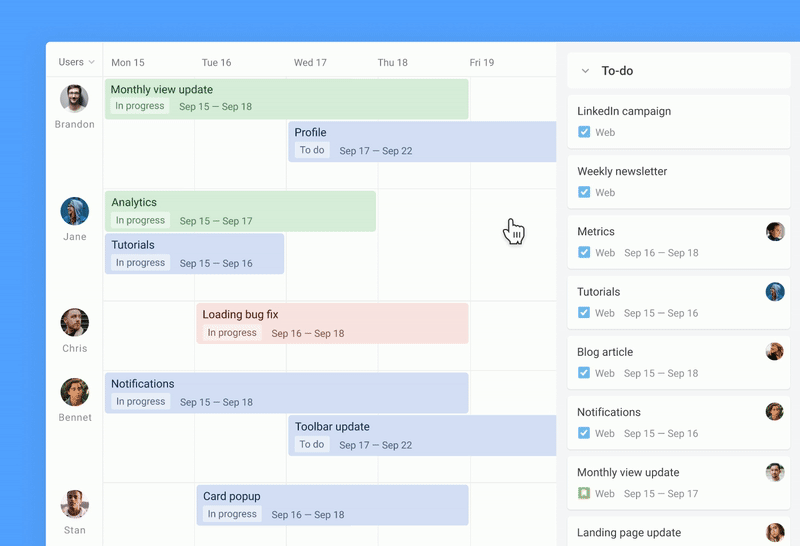
Planyway is a multifunctional Jira planner designed to simplify workflow management for small and medium teams. It provides a visual and intuitive way to manage Jira issues on a timeline, making it easier to plan project schedules, deadlines, and resources from a single place.Planyway's key features include:
Capacity Planning. Easily schedule tasks on the timeline grouped by members and allocate them to team members. Use Workload view to easily distribute tasks according to team availability.
Epic Timeline. Group tasks by epics to visualize project progress. This feature helps to visualize work on the high level.
Project Portfolio. Visualize work across multiple projects on the same roadmap so that you have a clear view across all your initiatives.
Subtask Visualization. Visualize subtasks along with Jira issues to represent the hierarchy of work tasks effectively.
Milestones and Releases. Highlight key dates with milestones to make them more recognizable within your roadmap.
Apart from the roadmap functionality, Planyway provides its users with time tracking and reporting, as well as calendar scheduling.
BigPicture
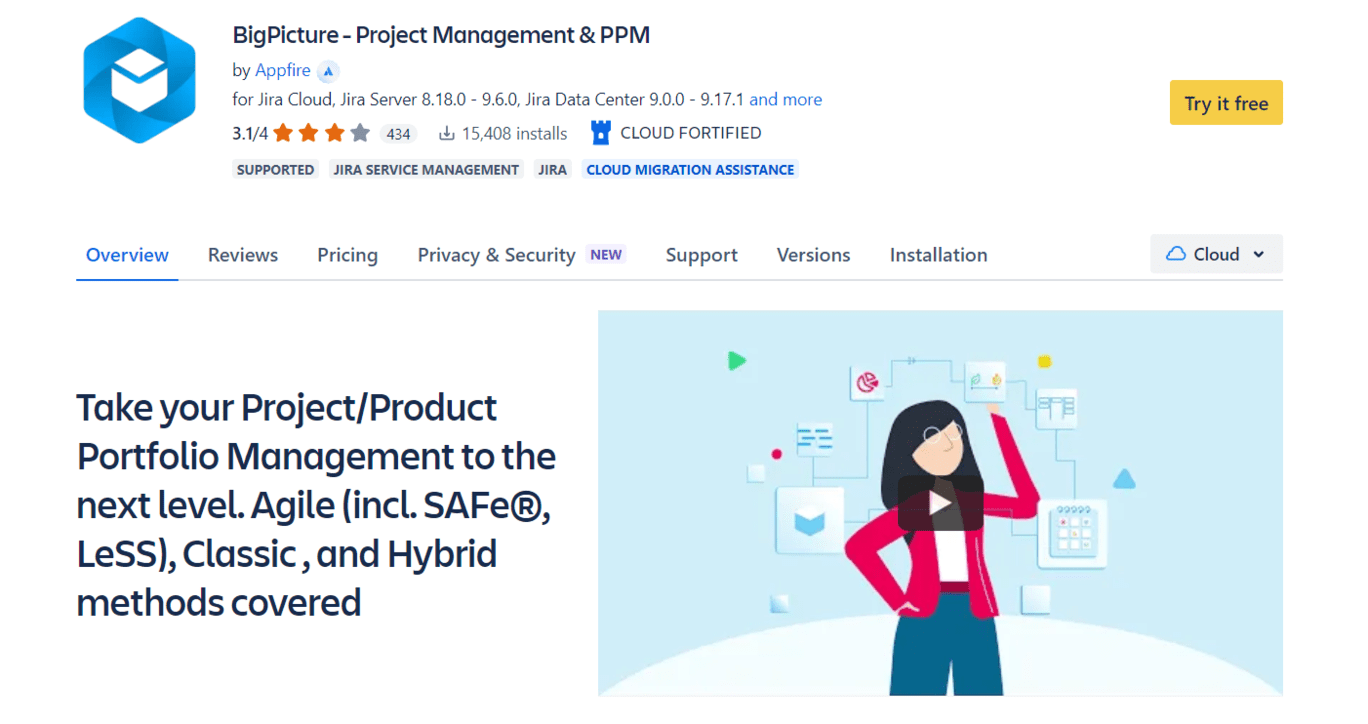 BigPicture is a comprehensive project management tool designed for medium to large teams. It offers extensive features to manage complex projects and Jira portfolio roadmap with ease. Key features of BigPicture include:
BigPicture is a comprehensive project management tool designed for medium to large teams. It offers extensive features to manage complex projects and Jira portfolio roadmap with ease. Key features of BigPicture include:
Gantt Charts. Provides detailed Gantt charts to plan and track project timelines, dependencies, and milestones.
Program and Portfolio Management. Allows users to manage multiple projects and portfolios, providing a high-level overview and enabling strategic alignment with business goals.
Resource Management. Facilitates capacity planning and resource allocation, ensuring optimal use of team members and preventing overload.
Risk Management. Includes features for identifying, assessing, and mitigating risks, helping teams to stay proactive and avoid potential issues.
Structure
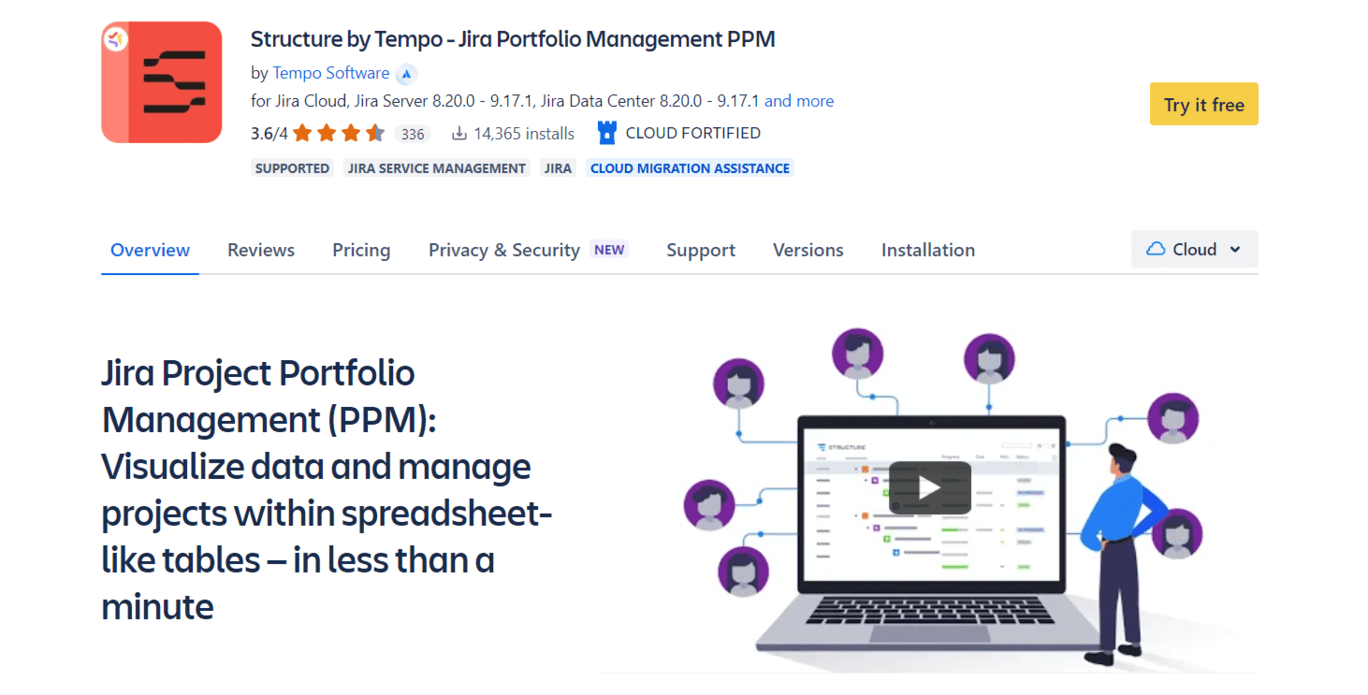 Structure is an advanced project planning and tracking tool tailored for teams that need to manage complex task hierarchies and dependencies. Key features of Structure include:
Structure is an advanced project planning and tracking tool tailored for teams that need to manage complex task hierarchies and dependencies. Key features of Structure include:
Hierarchical Issue Management. Allows users to create, manage, and visualize nested hierarchies of Jira issues, providing a clear structure of tasks and subtasks.
Flexible Views. Offers customizable views to display issues according to different criteria, such as by project, team member, or priority.
Aggregated Progress Tracking. Enables tracking of progress at different levels of the hierarchy, offering a comprehensive view of project advancement.
Automation Rules. Supports the creation of automation rules to streamline repetitive tasks and ensure consistency in project management.
Roadmunk
 Roadmunk is a user-friendly roadmap planning tool designed to help teams create visually appealing and strategic roadmaps. Key features of Roadmunk include:
Roadmunk is a user-friendly roadmap planning tool designed to help teams create visually appealing and strategic roadmaps. Key features of Roadmunk include:
Multiple Roadmap Views. Offers various views, such as timeline and swimlane, to visualize the roadmap in different formats suited to specific needs.
Collaborative Editing. Allows multiple team members to collaborate on the same roadmap in real-time, facilitating teamwork and alignment.
Presentation Mode. Provides a presentation mode for sharing roadmaps with stakeholders, making it easy to communicate plans and progress.
Feedback Collection. Includes features to collect feedback from stakeholders directly on the roadmap, enabling continuous improvement and alignment with stakeholder expectations.
Benefits of a Roadmapping in Jira
A product roadmap planner is a useful tool for product managers that gives detailed roadmap visualization to plan and communicate the strategic direction of a product, a project, or service. Some of the benefits of using roadmaps in Jira include:
Aligning Stakeholders. Ensures all team members share a common vision.
Prioritizing Features. Focuses on high-impact, strategic initiatives.
Planning for the Future. Outlines upcoming releases and milestones.
Communicating with Stakeholders. Shares plans and progress with executives, investors, and customers.
Managing Resources. Identifies dependencies, potential roadblocks, and skill gaps.
Adapting to Changes. Flexible updates to stay on track with shifting priorities or market conditions.
Conclusion
Overall, a well-constructed Atlassian roadmap not only facilitates efficient project management but also enhances strategic planning, stakeholder alignment, and resource optimization, ultimately contributing to the successful delivery of projects and products.
With the use of a comprehensive product roadmap template, Jira roadmap examples, and detailed Jira roadmap tutorials, teams can ensure they are leveraging Jira to its fullest potential for effective roadmap planning. Hope that this guide will teach you how to add roadmap to Jira and show you the best way to manage it further.
About the Author
Katarina Harbuzova is a seasoned content writer at Planyway, specializing in project management and productivity tools. With a keen eye for detail and a passion for simplifying complex processes, Katarina has crafted numerous guides and tutorials that help teams and organizations optimize their workflows.


